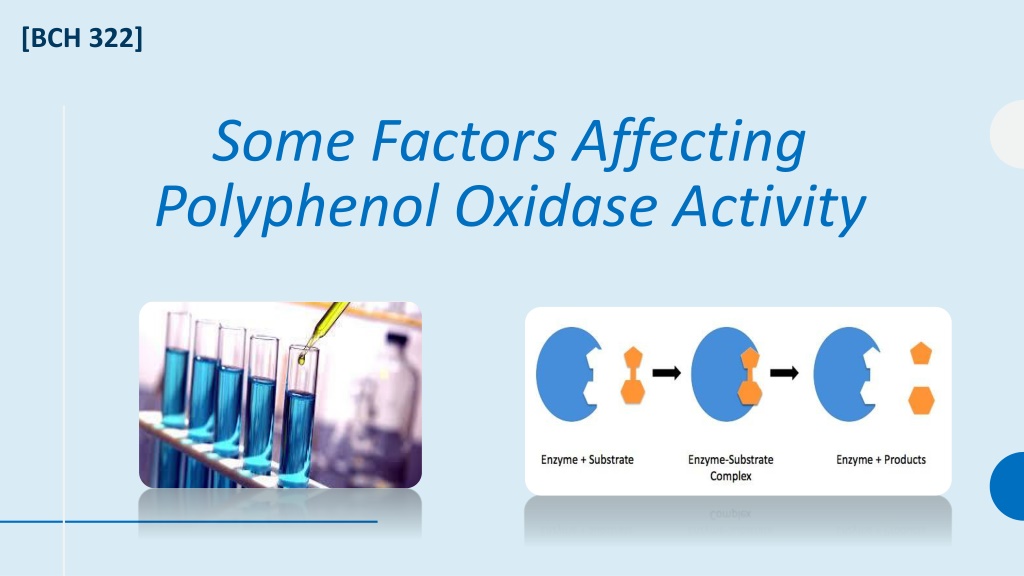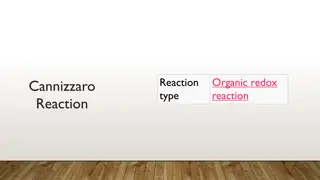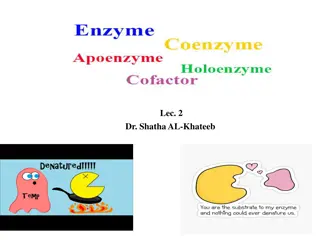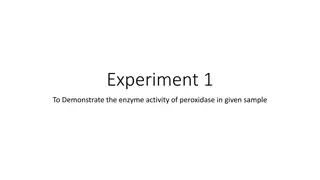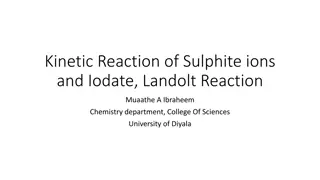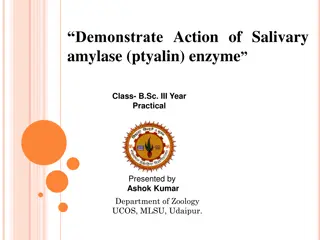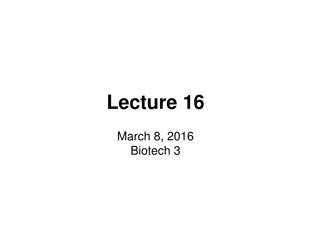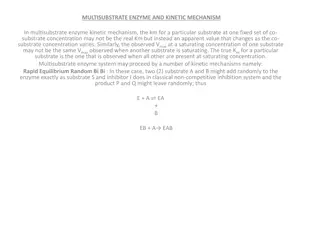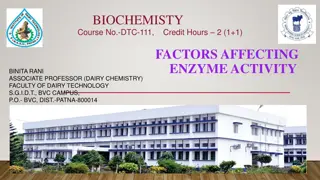Factors Affecting Polyphenol Oxidase Activity in Enzyme Reaction
Polyphenol oxidase (PPO) is a copper-containing enzyme with an optimal pH of 6.7 that catalyzes the oxidation of phenols, leading to color changes like browning in fruits and potatoes. This experiment aims to demonstrate PPO activity, its chemical nature, substrate specificity, and the effects of temperature. The qualitative tests involve observing color changes in enzyme-substrate reactions in test tubes over time. Understanding the conditions necessary for enzyme reactions like optimal pH and temperature is crucial for successful enzymatic reactions.
Download Presentation

Please find below an Image/Link to download the presentation.
The content on the website is provided AS IS for your information and personal use only. It may not be sold, licensed, or shared on other websites without obtaining consent from the author. Download presentation by click this link. If you encounter any issues during the download, it is possible that the publisher has removed the file from their server.
E N D
Presentation Transcript
[BCH 322] Some Factors Affecting Polyphenol Oxidase Activity
Polyphenol Oxidase (PPO): Is a copper-containing enzyme with an optimum pH of 6.7. It catalyzes the oxidation of di- and tri- hydroxyl phenol to the corresponding quinine. This oxidation-reduction reaction is accompanied by a color change This reaction commonly occurs in nature and accounts for the "browning" of peeled potatoes and bruised fruits.
Objectives: To demonstrate activity of the enzyme polyphenol oxidase in crude extract prepared from potato. To demonstrate the chemical nature of the enzyme. To investigate the substrate specificity of the enzyme. To investigate the effects of various temperatures on the activity of the enzyme. **All test done in this experiment are qualitative**
Exp.1- Test tube enzymatic activity: Principle: In this reaction we are looking for enzyme substrate reaction in general S + E ES P + E enzyme-substrate complex In this experiment you will notice the change qualitatively (change in the color). The intensity of this color (brown) will be proportional to the enzyme s activity in the tube under observation.
Method: a. b. Label three clean test tubes A, B and C. Prepare each tube as follows: Tube Addition 15 drops of enzyme extract. 15 drops of 0.01M catechol solution 15 drops of enzyme extract. 15 drops of distilled water. 15 drops of 0.0M catechol solution. 15 drops of distilled water TUBE A TUBE B TUBE C c. Place all three tubes in a water bath at 37 C. d. Shake each tube every 5 minutes to aerate, thereby adding oxygen to the solution. e. Every 5 minutes, after shaking, hold the tubes up to the light and examine. Record the color in each tube in the table. Continue for 25 minutes.
Degree of color intensity symbol No color change (colorless) Faint color (just detectable) + Definite color ++ Dark (deep) color +++ Results: Incubation time (minutes) Degree of color intensity (Symbol: , +, ++ or +++) TUBE A TUBE B TUBE C 0 5 10 15 20 25
Important notes: There are 3 terms for an enzymatic reaction to happen: 1. Presence of enzyme 2. Presence of substrate 3. Availability of appropriate conditions ( 37 C, pH 6.7) Enzyme If any of these terms are absent there will be no enzymatic reaction. Optimal pH and Temperature
Exp. 2- Chemical nature of PPO: Principle: As we all know majority of enzymes are proteins. Some are made of RNA They are high molecular weight compounds made up principally of chains of amino acids linked together by Protein (Enzyme) peptide bonds. It will be examined the nature of polyphenol oxidase wither is it protein or not RNA(catalytic)
a. Label four clean test tubes A, B, C and D. b. Prepare, and teat, each tube as follows: Tube (1) (2) (3) Add10 drops of : enzyme extract. 0.01M catechol TUBE A (control) Shake tube and place in water bath at 37 C for 10 minutes. Method Add 10 drops of: enzyme extract. 5% trichloroacetic acid (TCA). TUBE B Add 10 drops of 0.01M Shake tube thoroughly and catechol solution. TUBE C Add 10 drops of enzyme extract. Add a few crystals of phenylthiourea wait 5 minutes. Place in water bath at 37 C for 10 minutes c. Examine and compare with tube A, and record your observations in the table.
Degree of color intensity symbol No color change (colorless) Faint color (just detectable) + Definite color ++ Dark (deep) color +++ Results: Tube Treatment Degree of color intensity (Symbol: , +, ++ or +++) A B C Control TCA Phenylthioure a
TCA is an analogue of acetic acid widely used in biochemistry for precipitation of macromolecules, such as proteins, DNA, and RNA . Important notes It will effect the PPO activity by altering the pH of solution leading to denatured and inactivated enzyme. TCA treatments proves that the chemical nature of PPO is protein. Phenylthiourea has a very strong chemical affinity for the element copper (Cu+2). It is able to bind with Cu+2, even when the copper is attached to other chemical substances, as in the active site of PPO. This shows that copper is a cofactor for PPO. Question: If we treated the enzyme with trypsin before adding the catechol, will the reaction happen or not? And WHY? No, the reaction will not happen. Because trypsin is a proteolytic enzyme in other words it hydrolyses the peptide bonds which link the amino acid residues to denature and precipitate proteins, including enzymes.
Types of Enzyme Specificity There are four distinct types of specificity: Absolute specificity - the enzyme will catalyze only one reaction. Group specificity - the enzyme will act only on molecules that have specific functional groups, such as amino, phosphate and methyl groups. Linkage specificity - the enzyme will act on a particular type of chemical bond regardless of the rest of the molecular structure. Stereochemical specificity - the enzyme will act on a particular steric or optical isomer.
Exp. 3- Specificity of Enzymes: Principle: The three compounds used as substrates in this part of the experiment are structurally related (mono-, di-, and tri- hydroxyl phenol) Question: What type of specificity does PPO have? Group Specificity Main substrate ( highly specific) Phenol is a mono-hydroxyl phenol, and the enzyme only works on di- or tri- hydroxyl phenol. Hydroquinone is a di-hydroxyl phenol that can slightly change the active site configuration depending on induced fit model and gives a fait color reacting with PPO.
Method: a. Label three clean test tubes A, B and C. Tube (1) (2) Add 15 drops of 0.01M catechol solution Add 15 drops of 0.01M phenol solution 15 drops of 0.01M hydroquinone A 15 drops of enzyme extract. B C b. Shake the tubes gently and place them in a water bath at 37 C. c. Examine the tubes after 5 minutes and after 10 minutes. Record the color in each tube, in the table.
Degree of color intensity symbol Results: No color change (colorless) Faint color (just detectable) + Definite color ++ Dark (deep) color +++ Substrate Degree of color intensity (Symbol: , +, ++ or +++) 5 minutes 10 minutes Catechol Phenol Hydroquinone
Exp. 4-Temperature and enzymatic activity: Principle: * Low activity < Optimum Tm Optimum Tm*: is that Tm at which the activity of the enzyme is maximum
Method a. Label three clean test tubes A, B and C. Tube (1) (2) Incubate for 10 min at: (3) A 0 C Add 15 drops of 0.01M catechol B 37 C. Add 15 drops of enzyme C 70 C. a. Shake each tube gently and quickly return it to its proper temperature condition. a. Wait for 15 minutes. After this time, examine each tube, without removing it from its temperature condition, and record the color in each tube in the table.
Degree of color intensity symbol Results: No color change (colorless) Faint color (just detectable) + Definite color ++ Dark (deep) color +++ Temperature ( C) Degree of color intensity (Symbol: , +, ++ or +++) 0 37 70
